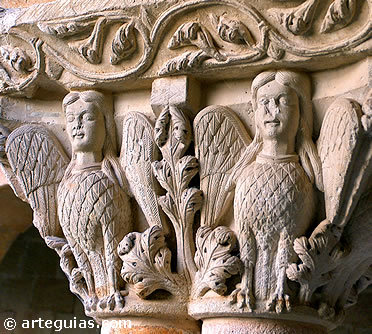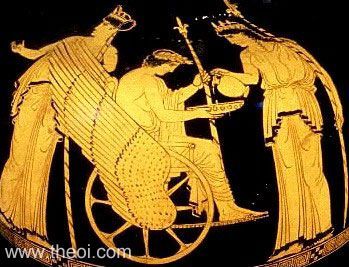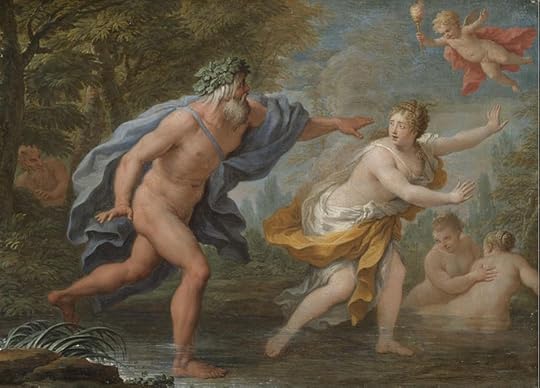 Kalliope’s
Comments
(group member since Aug 28, 2018)
Kalliope’s
Comments
(group member since Aug 28, 2018)
Kalliope’s
comments
from the Ovid's Metamorphoses and Further Metamorphoses group.
Showing 281-300 of 610
 On embedded narratives.
On embedded narratives. * The story of Pyreneus, told by the unnamed Muse is embedded at ONE level (Ovid + and the unnamed Muse).
* The Pierides entry in their contest with the Muses - a song about the monster Typhoeus attack on the gods , retailed to Minerva by an unnamed Muse is embedded at TWO levels(Ovid + the unnamed Muse + the Pierid singer).
* The Muses entry, the story of the rape of Proserpina and aftermath (originally told by Calliope but retold by unnamed Muse) is also at TWO levels (Ovid + unnamed Muse + Calliope).
* The latter contains Arethusa's autobiographical account of her near-rape, which she relates to Ceres and so is embedded at a THIRD level (Ovid + unnamed Muse + Calliope + Arethusa).
This creates a tripartite analogy between three pairs of audience and narrator - As Ceres is to Arethusa, and as Minerva is to the Muse reporting Calliope's song, so is the reader to Ovid.
There is a similarity in the tales told 'Arethusa's story parallels Calliope's about the rape of Proserpina, and these parallel the tales such as those of Apollo and Daphne that Ovid has told in 'propria persona'.
 Roger wrote: "
Roger wrote: "Yes, anything you can do to spur further discussi..."
OK... the notes contain some fascinating comments of the very complex narrative structure of embedded stories.. I will post more in a little while.
 I finished reading the Notes of the Simpson edition for Book 5.
I finished reading the Notes of the Simpson edition for Book 5.I will be posting a selection of the comments during this week.
 Elena wrote: "Roger wrote: "Which ones are beautiful in this book? I do agree about owls, though; Ovid gives them a bad rap. R."The feathered sirens with golden plumage and much musical talent..."
Elena wrote: "Roger wrote: "Which ones are beautiful in this book? I do agree about owls, though; Ovid gives them a bad rap. R."The feathered sirens with golden plumage and much musical talent..."Speaking of these 'sirens'.. I belong to a sort of group 'Friends of the Romanesque'. The lecturer is always telling us how the medieval 'sirens' are not what we think, but look like what Ovid describes. I smiled when I read the passage.

 Oh, I found him in the chariot.. In an ancient Greek vase. Beautiful.
Oh, I found him in the chariot.. In an ancient Greek vase. Beautiful.Anonymous. The Departure of Triptolemus. 480-440 BC. BM.

Stunning.
 Images with Triptolemus... I was hoping to find him with the chariot, but what I have is the crucial moment in the violent episode.. when Lyncus is strying to kill him and Ceres rescues him.
Images with Triptolemus... I was hoping to find him with the chariot, but what I have is the crucial moment in the violent episode.. when Lyncus is strying to kill him and Ceres rescues him.Jacques Dumont (1701-1781). Louvre.

But I did find him with the emphasis on agriculture. By the French Rococo painter.
Louis-Jean-François Lagrenée. 1770. Versailles.

 Reading the last part, with Triptolemus and Lyncus, I wondered (and the Classicists in the group may be able to help) about the history of the beginning of Athens... If Triptolemus, given that he is the one responsible (with Ceres's help) to make the area fertile, had a significant role.
Reading the last part, with Triptolemus and Lyncus, I wondered (and the Classicists in the group may be able to help) about the history of the beginning of Athens... If Triptolemus, given that he is the one responsible (with Ceres's help) to make the area fertile, had a significant role.
 Fionnuala wrote: "Did I say Pluto's advancing shadow earlier instead of Alpheus' — I loose track of these gods' individual names, so often are they bent on kidnapping and rape.
Fionnuala wrote: "Did I say Pluto's advancing shadow earlier instead of Alpheus' — I loose track of these gods' individual names, so often are they bent on kidnapping and rape. Thanks for those images, Kalliope - s..."
With all these raping names, that is why I was compelled to write some sort of table as my reading companion as we are transformed while reading Ovid. I think I would be lost without it (with it, I am also but to a lesser degree).
 Fionnuala wrote: "echoes Ovid's powerful description of Arethusa aware of Pluto's advancing shadow..."
Fionnuala wrote: "echoes Ovid's powerful description of Arethusa aware of Pluto's advancing shadow..."The mist that Diana creates to try and protect Arethusa from Alpheus reminded me of another different kind of cloud, the one Jupiter turned into when raping Io.
A few paintings on this episode, by less famous painters.
Carlo Maratta. 17C. Private.

Roman School. c 1640. High Museum of Art, Atlanta.
In this one I like the cloud.

Paolo de Matteis. 1710. Private.
This one is very Rubensian.

Luigi Garzi (1638-1721). Private.

 Roger wrote: "What is the Francine?
Roger wrote: "What is the Francine? ..."
No Francine. Autocorrect. The Francken. (had to correct it again !!).
Will edit it-
 Ovid must have had problems with 'informers' - here we have Ascalaphus turned into a bird (before we had the owl, the raven and the crow).
Ovid must have had problems with 'informers' - here we have Ascalaphus turned into a bird (before we had the owl, the raven and the crow).A few images on Ascalaphus. Prints.
Unkown to me. Harvard Museums.

Godfried Maes. (1649-1700)

Antonio Tempesta (1555-1630)

 I don't think this Rubens version of the Medusa head has been posted.
I don't think this Rubens version of the Medusa head has been posted.
Rubens and Snyders. Medusa. 1617-18. KHM Vienna.
 And another incident of impeded speech.
And another incident of impeded speech.Cyene wants to tell Ceres all she has seen but:
If Cyane had not been changed, she now
would have told Ceres all she knew; but while
she longs to speak, she lacks a tongue to tell.
(Mandelbaum)
 On various images..
On various images..Pluto's chariot with the black horses made me think of Apollo's and the white stallions.
Cyane dissolving into water - a contrast with so many of the characters turning into stone.
 Thank you, Roger, for posting the paintings on Cyane. I was going to post the Mignard and Francken.. you've saved me the trouble.
Thank you, Roger, for posting the paintings on Cyane. I was going to post the Mignard and Francken.. you've saved me the trouble.
 Jim wrote: "While we're still on Book V, I want to recommend for everyone's enjoyment a wonderful bit of fantasy on the Proserpina story, as woven by Zachary Mason in Metamorphica, his re-imagi..."
Jim wrote: "While we're still on Book V, I want to recommend for everyone's enjoyment a wonderful bit of fantasy on the Proserpina story, as woven by Zachary Mason in Metamorphica, his re-imagi..."Thank you, Jim. I did not know about this. Tempting for when we finish with Ovid. I am marking it.
 Roman Clodia wrote: " Their voices are effectively silenced ensuring that only one set of stories is received as orthodox, that of the muses who are entangled with Olympian Minerva and her own self-interest. The Pierides story that shows the Olympian gods as cowardly is suppressed and marginalised...."
Roman Clodia wrote: " Their voices are effectively silenced ensuring that only one set of stories is received as orthodox, that of the muses who are entangled with Olympian Minerva and her own self-interest. The Pierides story that shows the Olympian gods as cowardly is suppressed and marginalised...."I have just reread this post, RC, which had me thinking... I was a bit surprised that the story of the Giants and the Olympians was brought up again (although in Book I it had not been too developed, -- not as Giulio Romano did in Mantua), but as you say, presented in this context, as the 'alternative' story to the 'official' one it acquires a different meaning.
And again, the issue of trying to silence others is at play here again.
 I have just pulled the Velázquez catalogue out of my shelves - from the 1990 exhibition in the Prado. A major exhibition which I however could not visit since I did not live in Madrid then.
I have just pulled the Velázquez catalogue out of my shelves - from the 1990 exhibition in the Prado. A major exhibition which I however could not visit since I did not live in Madrid then.I had forgotten that the Prado curators had chosen the effigy of his Apollo as cover to the book.
Velazquez: Museo Del Prado 23 Enero/31 Marzo 1990

 Fionnuala wrote: "ihadbegun to think about an Ovidian trip... ..."
Fionnuala wrote: "ihadbegun to think about an Ovidian trip... ..."Actually, I am eyeing Pompeii as a possibility this year. It is a long time since I visited it.
Sicily on my list too - I have been there for one day only.

